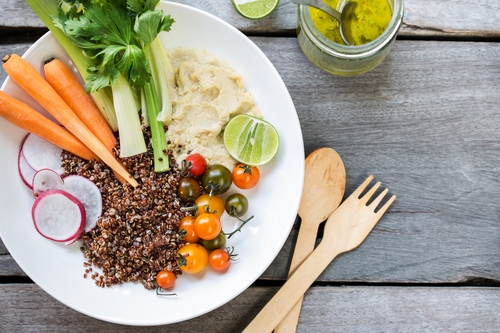Eating real food can be expensive. There, I said it.
Many people tout that eating real food is cheaper for the average family and no one should have financial issues switching to this new way of eating. While this may be true if your family has the time to cook every meal from scratch, many families cannot (or choose not to) prioritize “from scratch” cooking in their season of life.
This is currently true of my family. While I love cooking and I would love to cook every meal from scratch, it’s just not what I choose to do right now. My days are filled with college coursework, blogging, and 4 small children, while my husband is maintaining our garden, completing DIY projects on our 100 year old house, and working.
We are in a busy season in life, but we still feel that eating real foods is important and we try to prioritize this as best we can.
Buying organic and non-gmo is also slightly more expensive than buying traditional brands and products. Like most families, we are on a budget, so we’ve found a few ways to cut the costs of eating real food.
1. Get Cash Back, Coupons, and Rewards
I love shopping for great deals on real food, but I am not one to sign up for any and every rewards program out there. I have to know that it will be worth my time and energy and truly save my family money in the long run.
Swagbucks
One of the first rewards programs I joined was Swagbucks, and I still use it consistently after a couple of years. Through swagbucks, you can earn “swag bucks” by completing tasks, surveys, using their search engine, or shopping through their links.
You can then exchange your swag bucks for gift cards. I almost always choose Amazon gift cards so that I can buy organic food through my Amazon Prime account (such as organic coconut sugar and enjoy life chocolate chips).
Pro tip: Install the browser bar or download the smart phone app to get notification of free swag buck codes.
Ebates
One of my newest favorite rewards programs is Ebates. It works very similar to Swagbucks except that I earn cash back instead of points to use toward gift cards. Ebates doesn’t have a threshold for when you can get your cash back so it’s immediately transferred into my paypal account.
I can also use Ebates to shop at several “real food” online markets including Amazon.com.
Pro tip: Keep an eye out for double cash back rewards and promotions.
Amazon Rewards Card
Another favorite of mine is the Amazon Rewards Card which allows me to earn 3% cash back on Amazon purchases and 1-2% cash back on all other purchases.
A rewards credit card is not for everyone. If you cannot pay off your credit card every month, it’s definitely not worth it (as the interest would cancel out the rewards). However, it is a good options for those who will pay it off every month. The bonus is that it can also build your credit score.
Coupons
Before I check out at any online store, I always do a simple search on the web to make sure I am getting all of the discounts possible. Try Coupons.com or RetailMeNot.com for current coupon codes.
I know I’ve hit the jackpot when I can combine double cashback rewards with coupons and free shipping.
2. Subscribe and Save
Amazon Subscribe and Save
I’ve been an Amazon Subscribe and Save customer for several years now because they have a good selection of natural and organic foods and household products. The benefit of signing up for subscribe and save vs. just buying from Amazon Prime is that you get extra savings of anywhere from 5%-20% depending on how much you order each month.
Some items I order include:
- Organic Chia Seeds (get here)
- Organic Coconut Oil (get here)
- Organic Coconut Sugar (get here)
- Enjoy Life Chocolate Chips (get here)
- and more…
Vitacost
I am new to using Vitacost, but they have a large selection of natural and organic food, plus other supplements, vitamins, and household products. It is the only place online that I can buy Bubbies Pickles (naturally fermented pickles) and other Bubbies brand products.
They also have a “set and save” program that allows you to save money by signing up for regular shipment of your favorite products.
Sign up here to receive $10 off your first order.
3. Buy in Bulk
If there is an item in your pantry that you are consistently needing to replenish, consider buying it in bulk to save money. How will you know if it saves money? Simply calculate the price per unit and shop based on that price instead of per package.
For example, we eat a lot of rice as a family. At the store, it’s much cheaper (per ounce) to buy a 10lb or 20lb bag of rice than it is to buy a small 2lb bag.
Foods that are usually cheaper in bulk:
- Rice
- Nuts and legumes
- Flour
- Quinoa
- Spelt
- Honey and Sugar
Just remember, this method will not always save you money. Be very selective of what you buy in bulk. We do not buy snack foods in bulk because it would mean they disappear faster in our house. You also shouldn’t buy in bulk if the food in question will spoil before it gets put to use.
4. Keep a Price Book
Without some sort of system, it can get a bit confusing when shopping at multiple places both online and offline. How do you keep track of what is a good deal and what is not?
A price book is a way to record price trends (between seasons and between venues) for food items that you typically buy. It allows you to quickly see if what you are buying is a good deal or not.
It can be as simple as a list of the most common foods that you buy, or a detailed booklet listing each item you buy along with detailed information about when and where you have found the best deals.
I’ve used a price book over the years to keep track of when food items are at their lowest price (even without an advertised sale) and stock up accordingly.
5. Shop In-Season
One of the staples of a real food diet is fresh fruits and vegetables. This can eat up your food budget if you are constantly buying fruits and vegetables that are not in season.
Not only are out-of-season fruits and vegetables more expensive, they are often shipped from far away and depleted of nearly all of their beneficial vitamins and nutrients.
Kristen Michaelis highlights the importance of eating in-season fruits and veggies in Beautiful Babies:
The longer the fruit or vegetable is stored, the more vitamins it loses. Because of our modern, insatiable desire to eat all manner of fruits and vegetables out of season – all year ’round – most veggies and fruits are sometimes stored for months at a time before they’re finally brought to market.
Do your family and your wallet a favor and buy fruits and vegetables when they are in season and as locally as possible.
Go here for a list of which fruits and vegetables are in season in your area.
6. From Farm to Table
To the average family on the SAD (Standard American Diet), buying from local sources can seem exorbitant. However, when you have prioritized organic, natural, and real foods for your family, eating locally is actually one of the cheapest options available.
My family prioritizes foods from local and natural sources as much as possible, and save ahead for certain items.
For example, we try to put aside money every year to buy a quarter of locally raised beef. While the price-per-pound is a bit higher than your average pound of conventionally raised ground beef, when you factor in the steaks, roasts, soup bones, heart, and other cuts that we get, it’s much cheaper than buying all of those cuts at the store or the local butcher shop. It’s also much cheaper than organic or grass-fed beef from any other source.
The same is true of local honey, eggs, butchered chickens, raw milk, fresh bread, fruits and vegetables, as compared to conventional sources. In fact, it’s often much cheaper for us to buy local in-season produce from a farmer’s market than it is to buy organic from the store. Plus, nothing can beat the taste of something that’s been harvested the day before as compared to something that’s been shipped to the store.
So, tell me, how do you save money on real food?
~
Related Articles on the Web:
Save Money on Real Food by Buying in Bulk, Bartering, Working, and Making the Right Connections
Saving on Real Food: 3 Simple Secrets


These are some great ideas! I buy from Vitacost, iHerb, Nuts.com, have several items on the Amazon subscribe & save program, and I keep 3 separate lists of where the items I buy are the least expensive. I have this scheduled to share on my Facebook page, Refocus on Being. Thanks for the informative article!
Thanks Amanda. I will have to check out some of your sources!
You’ve got some great tips that I’ve not used. Like you, I’ve buy much of our things at Vitacost–especially the gluten free items I need and the green-pea flour for my dogs’ cookies. I’ve not found anywhere that I can beat that price on the coconut oil either! I also shop in season and freeze a lot. That way I know where it came from as well as when it was put up so it doesn’t get too old.
I can imagine it’s pretty handy to buy from there if you are gluten free.
Thanks for sharing the article. I find it costly to buy fruits and veggies when i go to a supermarket. When i’m able to get fresh vegetables i have family members and friends who have gardens and want to share. I also try and go to the farmers market and even flea market. Since i live in the deep South I can always find someone selling home grown vegetables from their own gardens, its like a yard sale for vegetables.
Great article! If I could add one, I’d recommend to check out local places you ordinarily wouldn’t! We have a Mexican supermarket near me that is our local “secret” for produce. Most people don’t go to it because they think it’s just Mexican food, but only a few people know that they have the largest, freshest, and cheapest produce! Our bill is at least half the price it would be at a major store, and the quality is immeasurable.